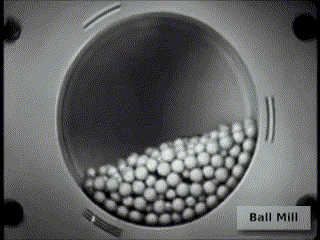Principle of Ball Mill & Operations?
A ball mill rotates its long shaft, and drive a jar which is placed on it. The friction of the rubber surface of the shaft can rotate the jar. The grinding beads (grinding balls) in the jar will constantly hit the sample due to gravity and mechanical force, like the below video:

After a long period of rotation and impact, the sample gradually changes from large pieces to small pieces, and small pieces to powder. The ball mill is the basic grinding equipment in a laboratory. Factories also often uses large-scale ball mill to manufacture powder.
The Factors Affects Grinding Efficiency
Spinning Speed
The faster the rotation speed, the greater mechanical force can be generated. The collision frequency can improve the grinding efficiency. However, with too fast rotation speed, it may reduce the frequency of grinding ball falling down and hitting the sample. It will reduce the efficiency. Too high a rotation speed may also cause the grinding jar to lose its adhesion stability and even cause danger to the operator.
Rotation Axis
A basic ball mill only rotates in one axis, and the forces in the other axial directions rely solely on the dispersion of forces in the other axial directions while grinding beads rolling. Some ball mills are designed with a swing mechanism, and the mechanical force extends to the other two axis and increase the collision force of the grinding beads in 3D direction. However, the increased mechanical complexity may influence the stability and durability of the machine during operation.
Grinding Time
Basically, the longer the running time, the finer the sample will be ground.
Size of Jar & Empty Space Inside
The two conditions affects the degree of freedom and collision distance between the sample and the grinding ball. Excessive empty space reduces the frequency of collision between the sample and the grinding beads. Otherwise, a crowded space makes the grinding beads and the sample have almost no distance in between, and the gravitational acceleration reduced, only rely on the weight of the grinding beads. A proper size of jar and empty space inside is also important.
Grinding Ball Size & Overall weight
The size of the grinding beads will affect the size distribution of the voids. In some occasions, mixed grinding balls with different sizes can have better grinding results. In addition, the more grinding balls filled, the greater the total weight. With the assistance of gravity, it is helpful to improve the grinding efficiency, too. However, the condition of empty space mentioned above and the upper limit of weight that a ball mill can drive must be considered.
Besides, a ball mill with weight and speed compensation and overload protection helps control conditions.
Advantages & Disadvantages of Ball Mill
- The structure of a single axis ball mill is relatively simple. Compared with other laboratory grinding equipment that costs hundreds of thousands of dollars, the purchase cost of the ball mill is low.
- The ball mill jars can be prepared, and even ready-made plastic cans and metal cans can be used, as long as the appearance is a standard cylinder.
- The operation setting is simple, and it is easy to control the relevant grinding conditions and variables.
- The source of impact and grinding force (rotating centrifugal force, grinding bead weight) is difficult to greatly increase under a fixed grinding tank size, and the grinding capacity is limited.
- The grinding time is also longer than that of an active oscillating impact or blade shear grinding machine.
- Samples are often attached to the grinding balls, and precious samples need time to collect and clean up.


